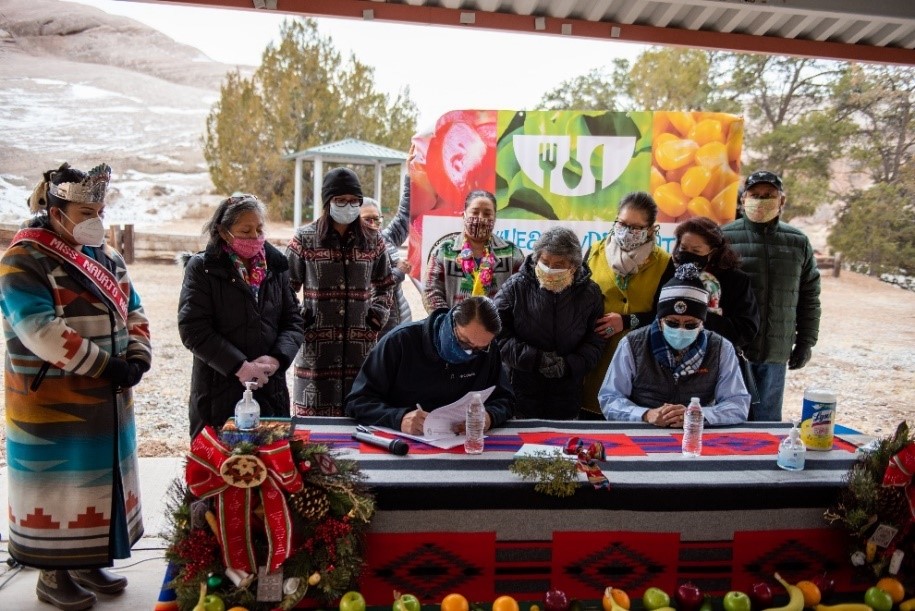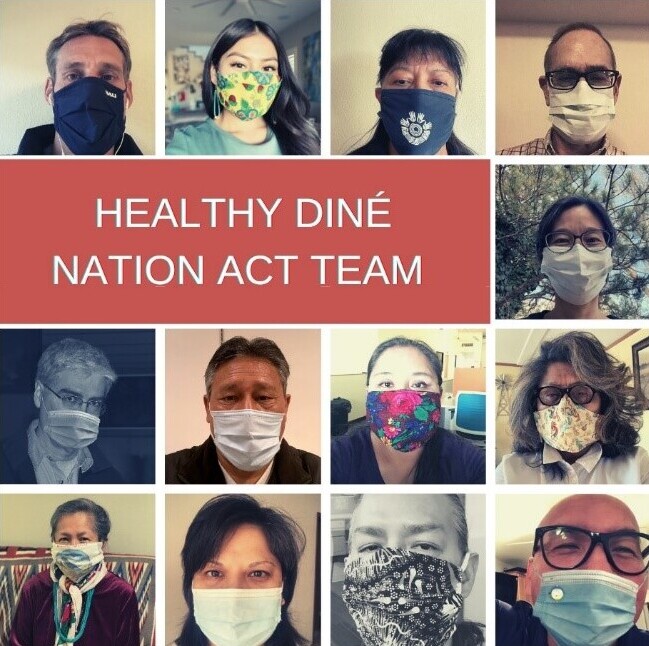Gloria Ann Begay, MA, has dedicated much of her life advocating for Native American food security and sovereignty. A member of the Navajo Nation, she is the Executive Director of the Diné Food Sovereignty Alliance (DFSA) and works with local Navajo community leaders to develop long-term strategies to ensure Navajo food security. “We look at how we can restore our food system,” says Gloria. “Ninety percent or more of our food is imported and that’s not the Navajo food system.”
The rates of obesity and diabetes within the Navajo Nation are much higher than the rest of the United States1. Part of Gloria’s long-term strategy is to help restore the balance of available, healthy food options and locally sourced and grown foods. Nearly 40% of Navajo Nation members feel that their communities are food insufficient, and even with food assistance programs, the lack of nutritious food options and the distance required to drive to a grocery store to purchase them, directly contribute to health problems in the community2.
“Projects are needed to benefit the community and our health,” Gloria says. Her work at the DSFA includes developing educational resources about growing traditional Navajo foods, including food workshops for children and young parents, and working with Navajo Nation President Jonathan Nez and local chapter leaders to create new options for quality, affordable food.
The Junk Food Tax
In November 2014, the Navajo Nation Council passed into law the Healthy Diné Nation Act of 2014 (HDNA), which enacted the first ever junk food tax within any sovereign tribal nation and within the United States. The Navajo people call themselves Diné, meaning “The People.” A 2% tax was levied on foods and beverages with minimal-to-no nutritional value and balanced with it was the removal of a 6% tax on water, fruits, and vegetables. The goal of the tax was to promote healthier diets and lifestyles in the Navajo Nation and provide new revenue for local community wellness projects (CWPs).

Gloria knew that an analysis of the tax impact was needed. “Our council delegates want up-to-date data,” she says. She partnered with Del Yazzie, MPH, an epidemiologist with the Navajo Epidemiology Center, to study how the tax was impacting the community and promoting wellness3. “We talked about ways to evaluate the junk food tax and how communities are utilizing the funds,” Del says.
Del is the first author on a new study, supported in part by the NIMHD, in Preventing Chronic Disease. The study reports on the economic impact of the junk food tax4. Together, Del and colleagues calculated that the junk food tax has generated over $7.58 million in gross revenue for the Navajo Nation since 2015. Importantly, nearly all that money was redistributed back to the 110 local Navajo Nation chapters to develop their own CWPs.

Del and Gloria partnered with the Office of the Navajo Tax Commission, Diné Community Advocacy Alliance, Diné College, Dr. Sonya Shin, MD, Research Director of the Community Outreach and Patient Empowerment (COPE) Program, and Dr. Hendrik ‘Dirk’ de Heer, PhD, MPH, Associate Professor of Health Sciences at Northern Arizona University.
“Gloria’s work with the Navajo Department of Health is rooted in historical oppression,” Dirk says. “Displacement, food insecurity issues…the Navajos were traditionally healthy and food sovereign. Gloria is working to control their own food and eliminating policies that undermine Navajo health.”
Promoting Health Awareness as One Path to Navajo Food Sovereignty
The redistribution of the junk food tax revenue directly back to the community is contributing towards realizing the goal of better food options and health behaviors. “Some communities are using the tax revenue to curb health disparities, such as building new hiking trails, and education on healthy eating,” Del says.
CWPs include the development of new greenhouses and other agricultural projects, the construction of playgrounds and recreational courts for basketball and volleyball, and instructional workshops on traditional Navajo foods5. “Community people plan, develop, and implement the community wellness projects” says Gloria, “[we’re] also looking for numerous ways to help the environment.”
Another important aspect of this collaboration is the communication of their findings, particularly with respect to informing local leaders about the impact of the tax and advocating for extension of the policy. “Having grown up here in Navajo, a lot of people are unaware of the junk food tax and we’re trying to inform our people,” Del says.
The educational and outreach component of their work has already influenced Navajo legislation and policy. The junk food tax was due to expire on the last day of 2020, but the tax was successfully and indefinitely reauthorized on December 31, 2020. The research team worked with Navajo National leaders, including Delegate Amber Crotty, who sponsored the legislation, to help reauthorize the tax. “This evaluation team has developed reports and health journals and documents that were instrumental to the Navajo Council in resolution to drop the sunset clause,” Gloria says.
“Originally, the tax was met with a lot of pushback,” Dirk says. “It’s our job to inform the Tribal Council, as this is the information that is needed for good policy.” The tax extension was unanimously approved just before it expired, partially due to how successful it has been. “Going forward,” Del says, “we need more time to further assess the health impact and to gain further insight.”
Follow-up projects will assess health behaviors using the Navajo Nation Health Survey1 (The Navajo Nation’s adapted version of the national Behavioral Risk Factor Surveillance System) and understanding food store environments as they relate to nutritious food availability and choice. The DFSA and Navajo Epidemiology Center have further partnered with the COPE Program to identify additional ways to encourage healthier food options.
COPE’s Prescription Fruits and Vegetable Program provides food vouchers to Navajo families to buy fruits and vegetables. “The Prescription Fruits and Vegetable Program encouraged stores to have more healthy foods,” Gloria says.
The impact has been felt beyond the borders of the Navajo Nation. When the junk food tax was enacted, bordering towns outside of Navajo Nation reacted to the removal of the 5% tax on water and produce. “The fruits and vegetables economy moved in response to the junk food tax,” Gloria says.
So far, these pieces and this research are part of the complicated puzzle of solving food sovereignty for the Navajo Nation. “It’s been quite a journey and I feel we’ve accomplished a lot,” Del says. Dirk agrees. He adds, “it’s about passing health policy in alignment with the needs and perspectives of their own people.”
There’s much more work to be done to achieve that long-term goal, but so far these partnerships and collaborations are making big impacts for the betterment of the Navajo Nation.
References:
- The Navajo Nation Health Survey (NNHS): Report of the Navajo Behavioral Risk Factor Surveillance Survey, Navajo Epidemiology Center. Accessed, February 23, 2021.
- Diné Food Sovereignty: A Report of the Navajo Nation Food System and the Case to Rebuild a Self-Sufficient Food System for the Diné People, Diné Policy Institute, Diné College. Accessed, February 23, 2021.
- ">Our Voice: Implementation Results of the Healthy Dine Nation Act 2016-2018, Navajo Epidemiology Center. Accessed, February 23, 2021.
- Healthy Dine Nation Act: Update on History, Tax Revenue, Chapter Wellness Projects, Food Store Environment and Community Surveys, Navajo Epidemiology Center. Accessed, February 23, 2021.
Page updated October 7, 2022
More Information
Read more about this research in the .
Learn more about Healthy Diné Nation Act of 2014 (HDNA) on the Navajo Epidemiology Center website.

